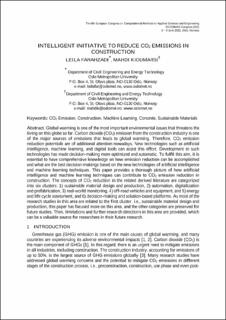| dc.description.abstract | Global warming is one of the most important environmental issues that threatens the living on this globe so far. Carbon dioxide (CO2) emission from the construction industry is one of the major sources of emissions that leads to global warming. Therefore, CO2 emission reduction potentials are of additional attention nowadays. New technologies such as artificial intelligence, machine learning, and digital tools can assist this effort. Development in such technologies has made decision-making more optimized and automatic. To fulfil this aim, it is essential to have comprehensive knowledge on how emission reduction can be accomplished and what are the best decision-makings based on the new technologies of artificial intelligence and machine learning techniques. This paper provides a thorough picture of how artificial intelligence and machine learning techniques can contribute to CO2 emission reduction in construction. The concepts of CO2 reduction in the related derived literature are categorized into six clusters: 1) sustainable material design and production, 2) automation, digitalization and prefabrication, 3) real-world monitoring, 4) off-road vehicles and equipment, and 5) energy and life cycle assessment, and 6) decision-making and solution-based platforms. As most of the research studies in this area are related to the first cluster, i.e., sustainable material design and production, this paper has focused more on this area, and the other categories are preserved for future studies. Then, limitations and further research directions in this area are provided, which can be a valuable source for researchers in their future research. | en_US |

